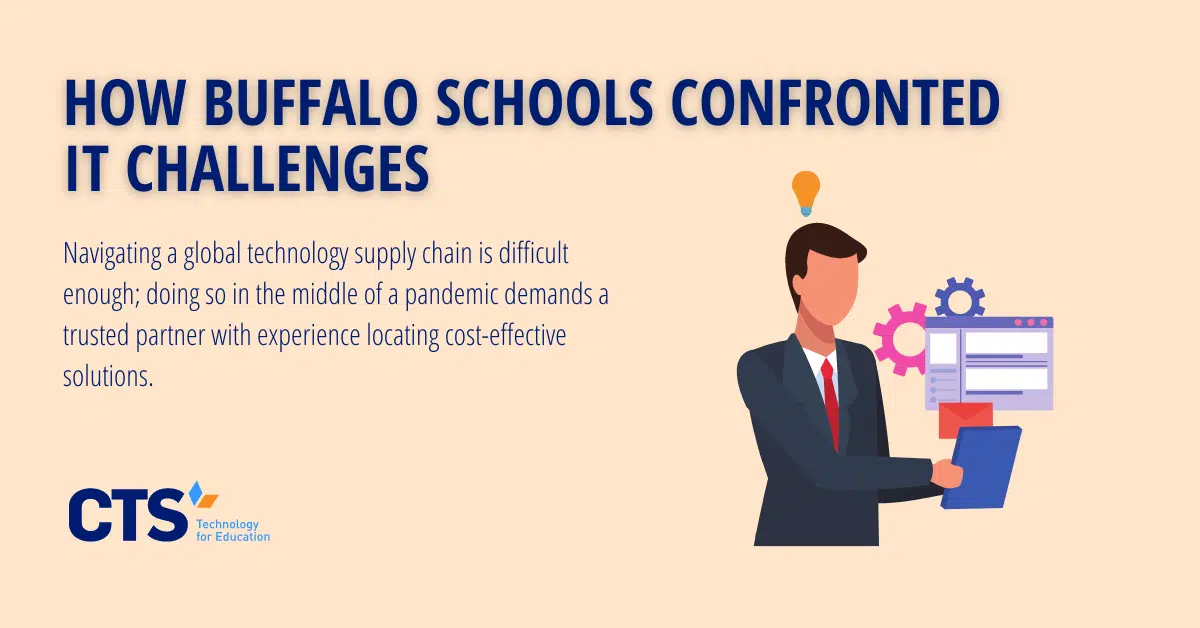In March 2020, schools in Buffalo and across the country scrambled to launch remote learning programs.
As schools across the country halted in-person learning during the pandemic’s early days, school leaders scrambled to launch remote learning programs. This unprecedented effort required teachers and students to quickly gain fluency in common educational technology platforms like Google Classroom as well as online videoconferencing tools like Zoom.
While some students had little trouble navigating these and other tools, younger students, in particular, required assistance. As a result, parents and family members often became de facto IT teams, forced to help their children navigate common technology problems and ensure students attended their scheduled classes at the correct time. For some parents, of course, this wasn’t an option: essential workers were still required to report to work each day, leaving young children in the care of older siblings or other relatives. Likewise, even those parents who worked from home were forced to juggle their own responsibilities with those of their students.
The difficulties of remote learning in Buffalo and across the country underscore the range of IT problems facing schools. Below, we highlight some of the challenges Buffalo schools, in particular, faced and outlined how CTS can help these and other schools tackle their most complex IT challenges.
Among the many challenges facing Buffalo schools was a low number of functioning devices.
Like schools across the country, the first task for Buffalo schools was to secure enough devices for each of their students to use during remote learning. While some schools may have had a sufficient number of student laptops on hand, others weren’t so lucky and were forced to compete with schools across the country to purchase a limited number of available devices.
Even schools with enough devices quickly discovered that many of them were defective or didn’t have the correct software installed. With each day that passed, students missed out on valuable instructional time, while parents became increasingly frustrated. Lines of family members and students seeking help wrapped around Buffalo school buildings, so much so that the local police had to assist with crowd control. While the district had set up a hotline for families to call if they encountered tech. issues, some families didn’t know the hotline existed and were forced to travel to a district building for in-person assistance.
Likewise, many students lacked consistent internet service at home.
Even with a functioning device in hand, some students in Buffalo schools didn’t have access to wireless internet at home, much less service that could handle the demands of remote learning. With multiple students logging on to Zoom and other videoconferencing platforms at once, even students who normally enjoyed home internet access encountered poor connection alerts and long loading times.
To mitigate these issues, Buffalo schools distributed wireless hotspots to many of the district’s students, who were then able to get online. But the district didn’t necessarily have enough hotspots to meet demand and, as with student laptops, were forced to compete with schools across the country for a limited number of devices. While some private internet providers offered free internet access for low-income families, knowledge of the companies’ offerings wasn’t always widespread. A lack of home internet access proved especially harmful to students with special needs and English language learners, some of whom had already struggled in school before the pandemic.
When students’ family members encountered issues with their children’s technology, troubleshooting could prove difficult.
Similarly, family members often became de facto IT providers when their students encountered issues with their school-issued devices. For younger students, in particular, family members were forced to stop what they were doing at a given moment, help their student log on to their device, and ensure the student joined their classroom’s Zoom conference at the appropriate time. But things didn’t always run so smoothly. For instance, with so many different Zoom links to navigate, students and their family members could inadvertently attempt to access an inactive link or end up in the wrong classroom, wasting valuable instructional time.
Even where a help desk was available, family members sometimes had to wait long periods of time before speaking with an IT team member. As family members waited on hold, their students missed out on valuable instructional time, and they, in turn, were forced to divert attention from their own work responsibilities.
Buffalo schools also faced ransomware attacks and other cybersecurity risks.
More than a year later, in March 2021, Buffalo schools also encountered an increasingly frequent threat to school networks across the country: ransomware attacks. When the attack was first discovered, the district was forced to cancel remote classes for the remainder of the school day and warned families that additional cancellations were possible if the school’s network wasn’t quickly restored.
Alongside the increase in remote learning, ransomware attacks targeting school districts have become increasingly common, sometimes compromising individual student data, which is held hostage by the attack’s perpetrator. Social security numbers, exam grades, and student birth dates are all potentially at risk, particularly in districts that lack the resources to implement strong data security protocols. Students miss out on valuable instructional time with each disruption, particularly if they attend class remotely. Without access to the school’s online resources, a student’s school-issued device or wireless hotspot is of little use.
At CTS, we help schools source, purchase, and set up devices for their students.
When the pandemic first impacted CTS’s partner schools, our team sprang into action to help them source, procure, and set up enough student devices to meet the needs of their students. Navigating a global technology supply chain is difficult enough; doing so in the middle of a pandemic demands a trusted partner with experience locating cost-effective solutions.
Once we help our school partners secure enough devices for their students, we also work with school leadership to align software choices with their broader instructional goals. Having worked in a range of school environments and across a number of different instructional models, our team has familiarity with a diverse array of educational technology products. It can help make recommendations to the school that align with instructional programming.
We also proactively monitor schools’ networks to help keep student data secure.
Of course, student safety and online security are paramount to any successful educational technology program. In addition to helping schools choose and install effective anti-virus software, we also collaborate with school leaders to create custom filtering options that determine which sites students can access on the school’s network. Doing so keeps students safe online and ensures that the school’s technology investments are used strictly for academic purposes.
We also proactively monitor our schools’ networks to look out for any potential intrusions and stop bad actors in their tracks. Part of this process includes implementing best practices in student device security. By limiting what sites students can access and what third-party content they can download, schools can go a long way in keeping their networks secure and, in turn, their students safe online. Our team can also recommend CIPA-related programming that enables schools to teach students how to recognize online threats and use their school-issued devices in a manner that ensures the network’s integrity.
When families, students, or teachers encounter issues with their technology, help is just a call away.
Perhaps most importantly, when technology issues arise, our team is there to help students, families, and teachers resolve them quickly so that instruction can continue. The last thing a busy teacher needs is a relatively minor technology issue that derails a carefully planned lesson. In addition to the stress it causes the teacher, the issue wastes scarce instructional time that, over the course of a year, can have a negative impact on student learning.
Similarly, as schools increasingly expand their programming beyond the building’s four walls, technology issues that appear during remote learning can compromise instruction. With just a call, students and families at CTS’s school partners can access a dedicated support team with the technical know-how to resolve all of the most common technology issues. By resolving these issues quickly, we ensure students can continue to access instructional content in a timely manner.
At CTS, we help schools in Buffalo and across the country tackle their most complex IT challenges.
Our team has decades of experience in the educational technology space. Rather than an ancillary component of school programming, we view technology as essential to our partner schools’ educational mission and work with school leaders to align our technology offerings with their unique instructional vision. Having worked with more than 60 schools across the country, we understand that no two schools are alike. We, therefore, invest significant time and energy into understanding the specific needs of each and every school with which we partner.
Schools in Buffalo and across the United States can count on CTS to take their technology programming to the next level and ensure in-person and remote learning success. Contact us today to learn more about our services and how we can help your school accomplish its unique mission.




